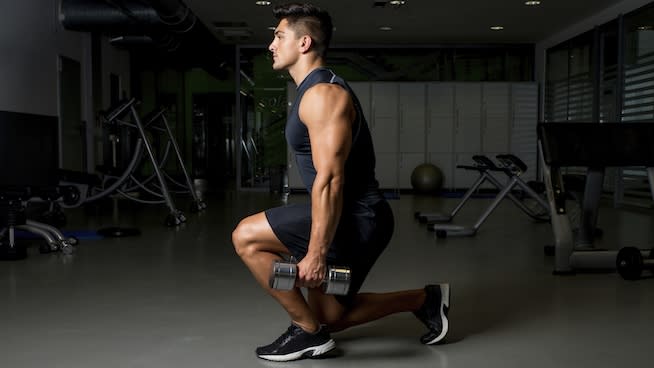Troubleshooting Tips for Popular Gym Exercises

Photo: Thinkstock
To a strength and conditioning coach, the sight of eager young athletes in the weight room both inspires and frightens. Although I love their youthful enthusiasm and the sense of invincibility they bring to their workouts, I often worry about how their penchant for disregarding proper lifting form will affect their ability to avoid injury over the long haul.
Sure, young athletes can withstand sloppy technique here and there. Young bodies are amazingly resilient. The question is, what happens when bad movement patterns become ingrained and various strength and flexibility imbalances worsen over time.
Not to mention that breakdowns in form usually occur when athletes add more weight to their lifts.
I think it will be helpful to troubleshoot some of the most common gym exercises and offer solutions to potential problems. That way, athletes can address the issues early, while they're still young, and hopefully avoid situations that might lead to more serious orthopedic problems down the road.
Squats
Problems:
Feet that pronate (arches flatten) and knees that cave in.
Lower back that rounds as you descend into the parallel (or below) position.
Causes:
In the case of foot pronation and knees pinching in, the culprit is usually some combination of weak glutes and tight adductor (inner thigh) muscles.
For the rounded back issue, tight hamstrings and weak core are typically responsible.
Solutions:
Strengthen the medial glutes with exercises like Mini-Band Clamshells and Lateral Band Walks, and perform adductor mobility drills like the Quadruped Rock, which usually work well.
Lengthen as you strengthen the hamstrings with Romanian Deadlifts, and work on maintaining a slight arch in your lower back as you squat by doing drills like the Squat to Stand. Start out with your heels slightly elevated (on a couple of weight plates), and as mobility improves, use a smaller heel wedge, until you can eventually do the drill with your feet on the ground.
Lunges and Split Squats
Problems:
Inability to hold your torso upright when executing Forward or Reverse Lunges or the Split Squat.
Poor knee tracking of either the front or back leg.
Causes:
Difficulty holding an upright torso can usually be attributed to tightness of the quads and hip flexors.
Failure of the front knee to track properly over the foot usually occurs when the knee pinches inward and the foot pronates, in which case, simply follow the advice in the Squat section, above. Sometimes, however, the back knee fails to line up directly under the hip in the bottom position of either movement. When a knee juts out slightly to the side, you're probably dealing with a tight iliotibial (IT) band.
Solutions:
Strive to increase hip mobility with the High Kneeling Hip Mobilization and Quad Stretches.
Use a foam roller on your IT bands and incorporate the Active Isolative Stretch.
Use a type of muscle contraction known as Eccentric Quasi Isometrics (EQI's), in either a Split Squat or Bulgarian Split Squat position to get your muscles and nervous system more accustomed to holding the bottom position of the movement. This technique is a great way to increase both strength and range of motion.
Overhead Presses
Problems:
Ribs that flare up, causing excessive arching of the lower back.
Inability to fully extend the arms overhead.
Causes:
Limited thoracic mobility and tight lats, causing excessive arching to make up for faulty movement mechanics.
Core weakness
Solutions:
Mobility work for the lats and thoracic spine, combined with core strengthening exercises that emphasize maintaining a neutral spine position. The three drills featured in the video above should significantly improve your ability to execute any overhead pressing movement.
Chin-Up / Pull-Up Variations
Problems:
Chest caves in as you near the top end of the range of motion.
Cutting the range of motion short by not lowering down until your arms are almost straight.
Causes:
Poor postural habits.
Weak, tight lats.
Solutions:
Focus more on your posture. This warrants a whole article by itself, but adding a drill like the Prone Cobra to your pre-workout warm-ups (as well as several times throughout the day) would be a good start.
In the case of weak, tight lats, in addition to the mobility drills featured in the video, Banded Pulls—starting with a supinated (palms facing you) grip and working up to the more demanding neutral and then pronated variations—will improve your ability to work through a full range of motion.
Isometric holds in the top position can also be extremely helpful, training you to focus on using your lats as much as possible. This great video by renowned strength coach Mike Boyle demonstrates both techniques.
Chest Presses
Problems:
Not engaging the lats and upper back to provide more stability for the shoulders.
Elbows that flare out in line with the shoulders as you press the bar or dumbbells away from your chest.
Causes:
Lack of awareness of proper body positioning and technique.
Weak triceps.
Solutions:
Pinch your shoulder blades together and down and contract your lats by essentially trying to "tear" the bar in half. This puts your shoulders in a much more bio-mechanically efficient position and reduces strain on the joint.
Tucking your elbows closer to your body (so they're essentially at a 45-degree angle to your torso) markedly increases triceps involvement—something young athletes often try to avoid, thanks to the body building-inspired practice of attempting to "isolate" the pecs. When pressing dumbbells, this is best achieved by using a semi-supinated or neutral grip, where the palms face each other throughout the pressing movement.
Read More:
This article originally appeared on STACK.com: Troubleshooting Tips for Popular Gym Exercises

